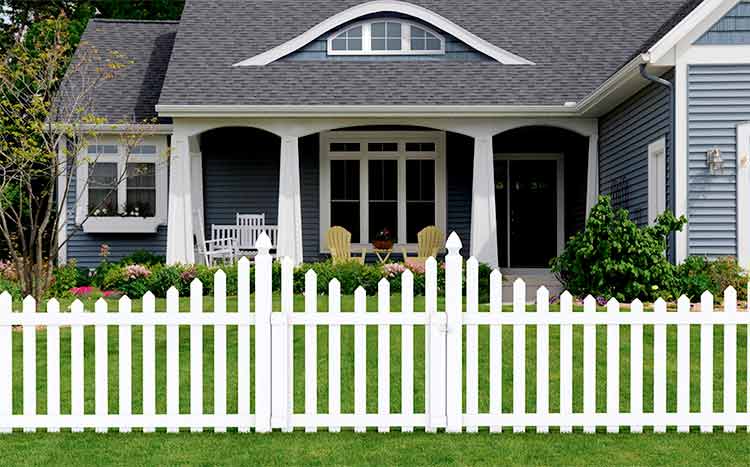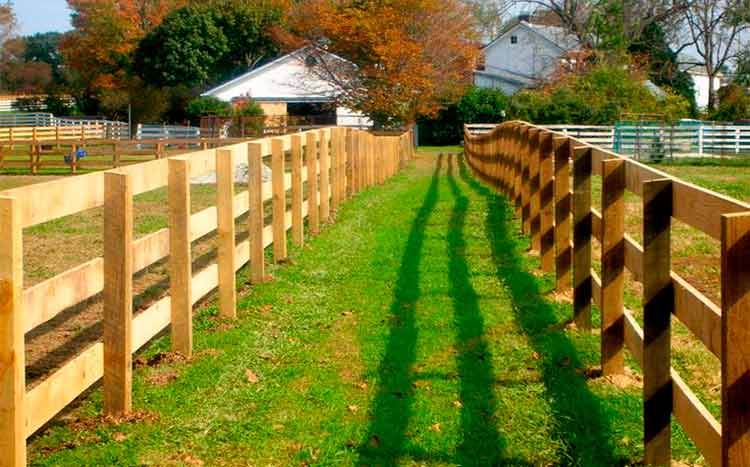Failing to comply with North Dakota’s building and fencing regulations, which cover everything from erecting a fence to other structures on your property, could lead to future complications. Like many states, North Dakota has a series of codes and laws regarding fencing. Additionally, it’s important to realize that municipal entities like cities, towns, and counties may enforce their specific rules about fencing that need to be followed.
Property line fences or boundary fences in North Dakota are covered under the state’s Century code sections 47-26-02, 47-26-05 & 47-26-06. A boundary fence is a fence that is built or erected directly on the boundary or dividing line between two adjacent lots. According to the code, neighbors sharing a property line fence are mutually and equally bound to maintain the fence.
What we cover
ToggleDo I Need A Permit to Build A Fence In North Dakota?
Building permits are required in some cities and townships for new construction, remodeling, addition, structural alteration, and mechanical projects such as building fences. This is to ensure compliance with local building codes and zoning requirements. You can obtain a permit from the relevant city or town hall department or have your fence contractor process it on your behalf.
However, some cities and towns in North Dakota do not require you to obtain a permit to build a fence. For instance, the city of Williston, ND does not require its residents to get a permit to build a fence but has comprehensive fence guidelines that must be followed. These guidelines include things like legal fence height, materials used, and positioning of fences on private lots in the city.
Obtaining a permit before you start erecting your fence or any other structure on private property is important because it saves you from inadvertently violating local building codes.
These codes are there to ensure your structures are built according to set standards. The permit will also protect you from claims from neighbors and subsequent owners of your property.
Can I Replace an Existing Fence Without A Permit?
Major repairs, structural alteration, or replacement of fences on private lots require a permit in cities or townships with a permit requirement in their building code of ordinance. Given that replacing a fence would mean using different materials or using different specifications, it is important to get a permit to ensure compliance.
A licensed civil works contractor in your location should be able to guide you on permit and fence requirements based on local building codes. Most of them have permit application templates and can apply for the fence permit on your behalf. If you are replacing the fence yourself, ensure that you obtain a copy of the local building code of ordinances and apply for a permit before you commence.
How Tall Can A Privacy Fence Be In North Dakota?
The average maximum fence height allowed in North Dakota is 7 feet based on fence building codes and building laws from across the state. However, you should refer to local building ordinances for the correct fence height. Most cities and townships in the state have specific fence requirements based on zoning districts and local building laws.
As an example, residents of the Williston, ND are not allowed to erect fences taller than 7 feet in rear and side yards and 4 feet in front yards according to local fence building guidelines. The table below contains fence height restrictions from select cities in the North Dakota State as per local fence laws:
| City/Township North Dakota | Maximum Fence Height- Residential |
|---|---|
| City of Williston | 7 Feet in Rear and side yards, 4 Feet on Front yards |
| City of West Fargo | 2 Feet 6 Inches on front yards (except for open fences such as split rail), 6 feet on rear and side yards |
| Bismarck, ND | 6 to 8.5 Feet depending on zoning district on front yards |
| Minot, ND | 4 Feet on Front yards and 6 Feet on rear yards- (additional requirements in the city’s ordinances) |
| Dickinson, ND | 4 Feet- 6 Feet depending on the Zoning district |
Who Owns the Fence on Property Lines In ND?
Adjoining landowners are mutually and equally bound to maintain boundary or property line fences and therefore, share ownership of the fence. This is according to North Dakota Century Code Sections: 47-26-02, 47-26-05 & 47-26-06 on boundary fences. However, local ordinances may have different provisions and take precedence depending on your location.
In general, it is expected that fences on shared property lines belong to both landowners because none of them can claim ownership of the boundary lines. You can avoid this by erecting your fence a few inches from the identified boundary line if it is practical to do so.
How Do You Know Where the Property Boundary Is?
While property lines or land boundaries are rarely identified or measured with absolute precision, you can get an accurate measurement or be able to identify it in different ways. Local land surveyors with knowledge of local land laws and procedures can help survey your lot, check available records, and help you identify the boundary line with fair precision.
Also, note that boundary lines are also available in relevant local city hall land departments or online if available as digital plat maps. Another option is to check the measurements of your lot on your title when you purchase it with the help of your realtor or lawyer before you erect a fence. Lastly, You can also get a metal detector to identify your property from the relevant office in your location.

Can My Neighbor Build A Fence On The Property Line?
Your neighbor has equal rights as you to put a common fence directly on the property line according to North Dakota boundary face law. However, the fence will not necessarily be their sole possession and you may be compelled to contribute towards its maintenance depending on local ordinances. In most cases, landowners with adjoining lots usually sign a property line agreement to avoid disputes arising from its usage.
Can I Put Up A Fence on My Side of The Property Line?
Yes, you have the same rights as your adjacent landowner to put or erect a fence on your side of your fence as long as it is legal and does not encroach on your neighbor’s land. Be sure to identify the correct property line before you erect the fence. Also, note that most cities or townships prohibit erecting fences directly on property lines next to public land or facilities such as roads.
What Is A Spite Fence?
A spite fence is a fence that inconveniences your adjacent neighbor, poses a danger, annoys them, or is undesirable in one way or another. While North Dakota fence laws do not specifically address spite fences, there are specifications in the statutes that essentially make them illegal.
At the same time, almost all cities and localities with fence ordinances have restrictions on residential and commercial fences that also make spite fences illegal. Be sure to check your local fence ordinances when planning or building your fence. Licensed local contractors often have copies of the relevant ordinances with them to help with compliance.
As an example, the city of West Fargo’s fence code of ordinances prohibits the erection of tall fences, those with electrified barbed wire or spiked materials that pose a danger to people. If your neighbor builds a spite fence, then you have a right to raise a claim with the local authorities and force them to demolish it.
North Dakota Boundary Fence Laws at A Glance
| Statues | Boundary Fences | Spite Fences |
|---|---|---|
| Boundary Fences: North Dakota Century Code Sections: 47-26-02, 47-26-05 & 47-26-06 Spite Fences: North Dakota Century Code Sections: 47-26-01 | Adjoining landowners are “mutually and equally bound” to maintain boundary fences; If one landowner chooses to erect a fence that exceeds the definition of a “legal fence” as defined by North Dakota law, that landowner must bear the entire cost of the fence; The law appoints members of the board of townships supervisors to act as “fence viewers” to resolve disputes; Boundary fences must be kept in good repair throughout the year unless both property owners agree otherwise. | North Dakota law doesn’t specifically address “spite fences”, but it does define “legal fence” as four and one-half feet tall; Some North Dakota cities also have ordinances governing the construction of fences, which could prevent a neighbor from building a spite fence that exceeds a local ordinance or building code. |
FAQ's
Who Owns the Fence Between Neighbors?
If a fence is sitting directly on the boundary or property line, then both neighbors own the fence and are responsible for its maintenance according to North Dakota boundary fence law. However, fences that are built inches away from the boundary line belong to individual landowners. Also, note that local city or county-level governments have fence ordinances.
What If A New Fence Is Blocking My View?
If a new fence blocks your view, then it may fit the definition of a spite fence or it might be illegal. Most cities and townships in North Dakota have fence height restrictions in their local building codes. Seek legal advice or raise a complaint with the local authorities in case you find yourself in this situation.
Can My Neighbor Hang Things on My Fence?
Neighbors are not allowed to hang things on your fence. You can raise a private nuisance claim against such neighbors with the help of a lawyer.
Can I Paint My Side of The Fence?
You can paint your side of the fence if it is built on the property line. However, you are not allowed to paint or alter a fence that is built away from the boundary and fully owned by the adjacent landowner without their permission.
Can I Build A Fence Next to My Neighbor’s Fence?
Yes, you are allowed to build a fence next to your neighbor’s fence according to the North Dakota fence code. You may be required to maintain the space left between your land and your neighbors in some places in the state.
Can I Put Up A Fence Without A Survey?
You can put up a fence without a survey provided you have identified the correct boundary line. However, it is advisable to do a survey and mark the boundary line to avoid encroaching on your neighbor’s land.













